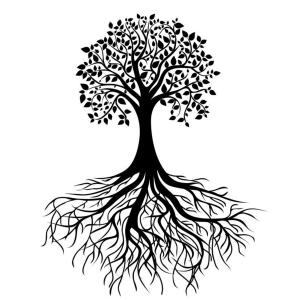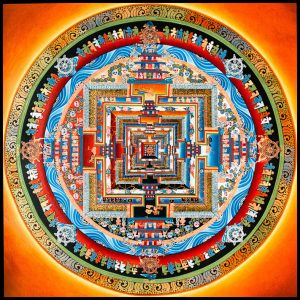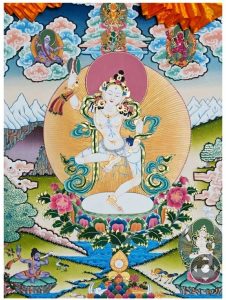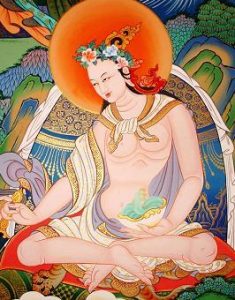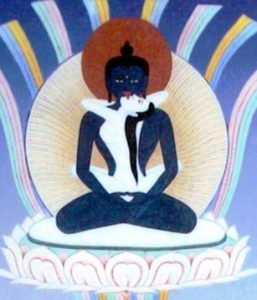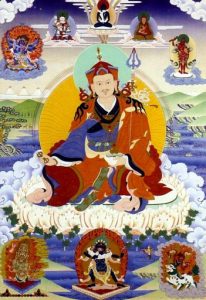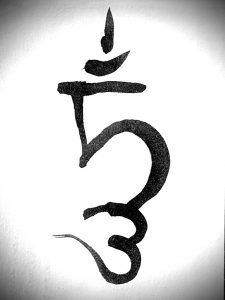“Wherever the Buddha’s teaching has not spread wherever it has spread but has declined may I, moved by great compassion, clearly elucidate this treasury of excellent benefit and happiness for all.”
H.H. Dalai Lama
Bodhgaya, Bihar, India – During three days in Dec. 2023 C.E. His Holiness the Dalai Lama gave teachings at the Kalachakra Ground. Exerpts here follow:
Day 1
“Whatever kind of discourse is being given,” His Holiness began, addressing the crowd [gathered at Bodhgaya, Bihar, India], “it’s important that we first check our motivation. This applies to both the teacher and the taught. We should avoid the eight worldly concerns. The teacher should neither be selfish nor only in search of peace. Disciples should not be absorbed by the pleasures of this life. All should seek to benefit others.”
“We’ll recite the verse for taking refuge and cultivating the awakening mind of bodhichitta. The Buddha, Dharma and Sangha are the objects of refuge and the reason we turn to them is to attain unsurpassable enlightenment in order to be able to lead all sentient beings to liberation.”
“Having met with the teaching of Buddha Shakyamuni, it’s good to recognize that whatever he taught was rooted in his own experience. He had overcome all mental afflictions and the obstructions to knowledge that are their residue. As is written in the ‘Sublime Continuum’ (Uttaratantra), all sentient beings have the potential to attain Buddhahood, but their minds are shrouded in defilements.”
“Since the defilements are not of the same nature as the mind, they can be eliminated and the intrinsic, luminous, clear light nature of the mind can be made manifest. This means that we can achieve the omniscient state that the Buddha has reached.”
“Defilements leave residual stains that function as obstructions to knowledge, but they too can be overcome. Because the nature of the mind is clear light, it is stainless by nature. It is by purifying our minds that we can achieve the same state as the Buddha. And it is possible to purify our minds because the various defilements are adventitious and temporary, while the intrinsic nature of the mind is clear and knowing. It is clear light.”
“From my own experience, having reflected long on the awakening mind of bodhichitta and the wisdom understanding emptiness —method and wisdom— I infer that mental defilements are only temporary. They do not obscure our minds forever. Although I have not developed single-pointed concentration, I think that of the five-fold path I can achieve the path of preparation.”
“The antidotes to our mental defilements and obstructions to knowledge are two— bodhichitta and an understanding of emptiness. If we develop these we can achieve Buddhahood as Shakyamuni has done. We can cultivate the courage and determination to do so because the basic nature of the Buddha’s mind and our minds is the same. The mind we have now will ultimately become the mind of a Buddha.”
“Today, the teaching is focussed on ‘In Praise of the Dharmdhatu’ by Nagarjuna. The text begins with homage to the dharmadhatu that is the Buddha nature that abides in every sentient being. But because they aren’t aware of it, they spin through the cycle of existence. However, when what gives rise to the cycle of existence is purified, it becomes nirvana and likewise, dharmakaya, the Truth Body of a Buddha. The empty nature of the Buddha’s mind and our minds is just the same. We can have confidence that because dharmadhatu is stainless, it is possible to attain the Dharmakaya.”
“We regard things as having independent existence, which is to cling to ignorance. We must recall instead that the nature of the mind is empty, and things are merely designated. As long as the clear light nature of the mind is shrouded in defilements, we remain sentient beings. When they are removed, we become enlightened.”
“We’ve gathered here in this sacred location where enlightenment took place,” His Holiness observed, “and we’ve gone through this text ‘In Praise of Dharmadhatu’. On my part, I do my best to cultivate the awakening mind of bodhichitta and an understanding of emptiness every day, not with a view to this life alone, but, as the famous verse says, ‘as long as space remains’. I urge you my Dharma friends to do the same as best you can.”
Day 2
“Today, in this very special place, Vajra-asana, the seat of enlightenment,” His Holiness observed, “people have gathered from many different countries and have the opportunity to make prayers. All sentient beings are the same in not wanting the slightest suffering, and, especially in the case of human beings, seeking joy.”
“As human beings we have the ability to look for reliable methods to overcome suffering and generate happiness. However, far too often, we look at things from a narrow point of view and only end up making ourselves unhappy. We lose our way in pursuit of short-term gratification.”
“No other creatures are quite like human beings, who, although intelligent, create suffering for themselves and others. We’ve seen the horrors of the first and second world wars and yet there are those who would have us prepare for the third. We pour energy and resources into constructing sophisticated weapons whose only purpose is destruction.”
“We need to be aware of the mistakes we have made and engage instead in practices that will create happiness and reduce suffering for everyone. We must work to avert war and forgo the use of weapons. We should no longer think in terms of complete victory for ourselves and the abject defeat of our adversaries. We must avoid thinking of our fellow human beings in terms of ‘us’ and ‘them’ and seek to live in peace and harmony with each other.”
“The real root of happiness is having a compassionate mind. If we just let ourselves be flung here and there by anger and hatred, there’ll be no peace in the world. But if we cultivate a warm-hearted attitude towards others there will be hope.”
“We had no weapons in our hands when we were born. Indeed, at that time we were nurtured by our mother’s love and affection. We would do well to keep this experience alive as we grow up.”
“It’s both sad and unfortunate that so many people seem set on killing each other. How much better it would be if they focussed instead on creating a loving atmosphere around them. Because we want to be happy and not to suffer, we should work to cultivate ‘karuna’, compassion, within. Then we’ll contribute to peace in the world. If we have love and compassion in our hearts, we’ll be on good terms with those around us. We have a responsibility to create peace in the world. This means doing our best to build peace within and without.”
“Today,” His Holiness announced, “we’ll cultivate the all-encompassing yoga mind. Most of us here are Buddhists, who pray to reach Buddhahood. The first syllable of the Tibetan word for Buddha—Sang—indicates that he has overcome all defilements. The second syllable—gyé—refers to his having acquired all qualities. So, our goal is to reduce the defilements in our minds and acquire all good qualities, thinking not only of ourselves, but of all sentient beings. The more we focus on the welfare of others, the more positive qualities we accrue.”
When it came to cultivating the all-encompassing yoga mind His Holiness advised his listeners to focus on the thought of bringing benefit to all sentient beings, infinite as the expanse of space, aspiring to lead them all to the state of Buddhahood. This amounts to generating conventional bodhichitta. His Holiness prompted the disciples to visualize this mind transforming into a moon disk at their hearts.
Next, His Holiness reminded them that although things appear to exist independently and objectively, they are actually dependent on other factors and exist as merely designated. He added that we too are all dependently arisen and have no objective status. Even the Buddha only exists in terms of designation.
His Holiness advised his listeners to imagine this thought of ultimate bodhichitta, the insight that all phenomena lack of inherent existence, arising in the form of a white, five-spoked vajra standing upright on the moon disk they had already imagined at their hearts. He asked them to repeat: Om sarva yogacitta utpatayami Then, to stabilize their minds and make the mind of all-encompassing yoga firm he asked them to recite: Om surate samaya satvam ho siddhi vajra yatha sukham.
“What I’ve learned about these two practices I’ve reflected and meditated on over many years. And I’ve seen the impact they have had on my mind. If you also cultivate these practices well, you’ll be able to embark on the path to enlightenment in this life.
“It’s because I recall emptiness and cultivate the awakening mind of bodhichitta from the moment I wake every morning that I am relaxed and at ease. Please keep this in mind. That’s all.
“Tashi delek.”
Day 3
“The Buddha, like a majestic mountain possessed of all qualities, became a Buddha as a result of accumulating merit and wisdom for three countless aeons. He attained Buddhahood beneath the Bodhi Tree near here. He was a teacher who revealed the truth and the path to it as they are.
“When we say I take refuge in the Buddha, we acknowledge the possibility of overcoming all defilements—attaining their true cessation. When the Buddha told us, ‘You are your own master’, he meant that we must practice. His powerful statement tells us that the future is in our hands. It’s not that anyone else can or should practice on our behalf. We spin through the cycle of existence because our minds are unruly. There are antidotes to suffering and its causes. By applying them we can actualize a purified mind, and that’s something to be proud of.
“As soon as I wake in the morning, I recite the verse for taking refuge and generating the awakening mind, which gives me strength to work for others. So, just as I make the cultivation of bodhichitta my main practice, you, my Dharma brothers and sisters should do so too. It will bring you peace of mind and physical well-being. This is what I say:
Having generated the spirit of supreme enlightenment
I invite all sentient beings as my guests to this feast of temporary help and the ultimate goal of enlightenment.
I will engage in the supreme and wonderful conduct of a bodhisattva,
May I attain Buddhahood for the benefit of all living beings.
“I urge all of you to cultivate a wish to benefit others as well. However many years I have left, I dedicate myself to extending my awakening mind.”
The Dalai Lama noted that in Buddhist practice it’s important to be able to use intelligence to develop wisdom. This is so necessary when it comes to overcoming mental afflictions and their imprints that function as obstructions to knowledge. He quoted lines from the prayer Jé Tsongkhapa wrote at the end of his ‘Great Treatise on the Stages of the Path to Enlightenment’.
Wherever the Buddha’s teaching has not spread
And wherever it has spread but has declined
May I, moved by great compassion, clearly elucidate
This treasury of excellent benefit and happiness for all.
Having given permissions related to the body, speech and mind of Manjushri, His Holiness led the congregation in reciting Om ara patsa na dhih together, followed by an exhilarating repetition of the syllable dhih.
Next, His Holiness gave the reading transmission of a prayer to The Eight Medicine Buddhas that he composed.
A thanksgiving mandala was offered and the occasion was concluded with the stirring chorus of hundreds of monks’ voices in sonorous tones chanting the Dedication Prayer from the end of ‘Great Treatise on the Stages of the Path to Enlightenment’.
Source:
https://www.dalailama.com/news/2023/teachings-in-bodhgaya-first-day
https://www.dalailama.com/news/2023/teachings-in-bodhgaya-second-day
https://www.dalailama.com/news/2023/teachings-in-bodhgaya-third-day


